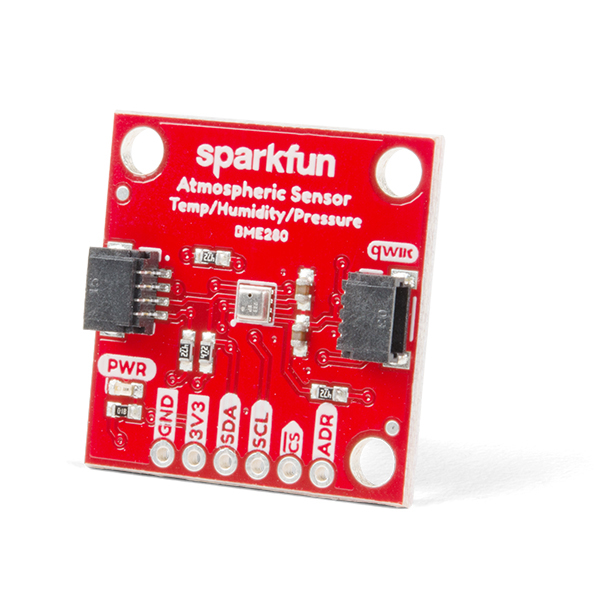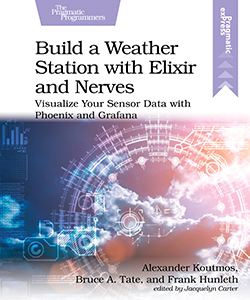Hello BMP3XX
bus_name = "i2c-1"
bus_address = 0x77
Mix.install(
[
{:bmp3xx, "~> 0.1.7"},
{:circuits_i2c, "~> 2.0"},
{:circuits_sim, github: "elixir-circuits/circuits_sim"},
{:kino, "~> 0.12.2"}
],
config: [
circuits_i2c: [default_backend: CircuitsSim.I2C.Backend],
circuits_sim: [
config: [
{CircuitsSim.Device.BMP3XX,
[bus_name: bus_name, address: bus_address, sensor_type: :bmp180]}
]
]
]
)Introduction
This notebook demonstrates how to read temperature, humidity etc from Bosch environment sensors. Our Nerves target device will communicate with a sensor board using the I2C protocol.
We need a few libraries for using a Bosch environment sensor in this notebook:
- The circuits_i2c package allows us to communicate with hardware devices using the I2C protocol
- The experimental circuits_sim package provides simulated I2C devices
- The bmp3xx package abstract the logic to use Bosch environment sensor boards
The bmp3xx package support various environment sensors including:
- BMP180
- BMP280
- BMP384
- BMP388
- BMP390
- BME280
- BME680
Running this notebook on the Nerves Livebook firmware, you can access directly to the real sensor board.
If you don’t have a real sensor board, don’t worry. It’s possible to work with a simulated device that is configured in the setup section above.
i2c_backend_select_form =
Kino.Control.form(
[
i2c_backend:
Kino.Input.select(
"I2C backend",
[
{CircuitsSim.I2C.Backend, "Simulated I2C"},
{Circuits.I2C.I2CDev, "Real I2C"}
]
)
],
submit: "Select I2C backend"
)
Kino.render(i2c_backend_select_form)
Kino.listen(i2c_backend_select_form, fn event ->
selected_backend = event.data.i2c_backend
Application.put_env(:circuits_i2c, :default_backend, selected_backend)
IO.puts("Selected I2C backend: #{selected_backend}")
case selected_backend do
CircuitsSim.I2C.Backend ->
sensor_type_select_form =
Kino.Control.form(
[
sensor_type:
Kino.Input.select("Sensor type", [
{:bmp180, "bmp180"},
{:bmp280, "bmp280"},
{:bmp380, "bmp380"},
{:bme280, "bme280"},
{:bme680, "bme680"}
])
],
submit: "Select sensor type"
)
Kino.render(sensor_type_select_form)
Kino.listen(sensor_type_select_form, fn event ->
selected_sensor_type = event.data.sensor_type
IO.puts("Selected sensor type: #{selected_sensor_type}")
[{_, i2c_server, _, [CircuitsSim.I2C.I2CServer]}] =
Supervisor.which_children(CircuitSim.DeviceSupervisor)
:sys.replace_state(
i2c_server,
&%{&1 | device: CircuitsSim.Device.BMP3XX.new(sensor_type: selected_sensor_type)}
)
Circuits.I2C.detect_devices()
end)
Circuits.I2C.I2CDev ->
Circuits.I2C.detect_devices()
end
end)Basic usage
The basic usage only takes two steps:
- start a BMP3XX server
- read output
stop_bmp3xx = fn _event ->
if Process.whereis(BMP3XX) do
GenServer.stop(BMP3XX)
IO.puts("BMP3XX was stopped")
end
end
start_bmp3xx = fn _event ->
stop_bmp3xx.([])
BMP3XX.start_link(bus_name: bus_name, bus_address: bus_address, name: BMP3XX)
end
start_button = Kino.Control.button("Start BMP3XX")
Kino.listen(start_button, start_bmp3xx)
stop_button = Kino.Control.button("Stop BMP3XX")
Kino.listen(stop_button, stop_bmp3xx)
Kino.Layout.grid([start_button, stop_button], columns: 2)BMP3XX.measure(BMP3XX)Optionally, you can force the altitude to a known value.
BMP3XX.force_altitude(BMP3XX, 100)For details, refer to the API reference.
Hardware
For the curious, here is some information about the Bosch environment sensors.
- Sparkfun’s BME68x(Qwiic) Hookup Guide
- BMP180 data sheet
- BMP280 data_sheet
- BMP388 data_sheet
- BME280 data_sheet
- BME680 data_sheet
For a hands-on Nerves tutorial, checkout this book.



